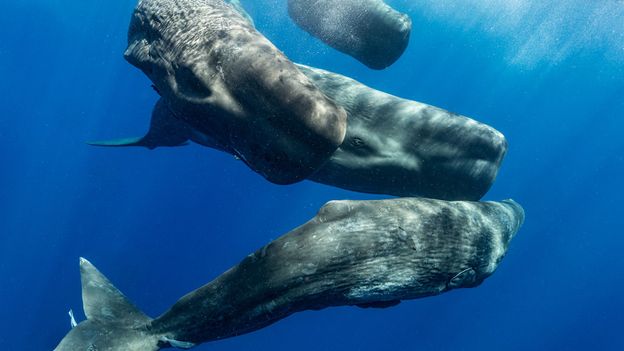Sperm whales communicate with each other using rhythmic sequences of clicks, called codas. It was previously thought that sperm whales had just 21 coda types. However, after studying almost 9,000 recordings, the Ceti researchers identified 156 distinct codas. They also noticed the basic building blocks of these codas which they describe as a “sperm whale phonetic alphabet” – much like phonemes, the units of sound in human language which combine to form words.
Pratyusha Sharma, a PhD student at MIT and lead author of the study, describes the “fine-grain changes” in vocalisations the AI identified. Each coda consists of between three and 40 rapid-fire clicks. The sperm whales were found to vary the overall speed, or the “tempo”, of the codas, as well as to speed up and slow down during the delivery of a coda, in other words, making it “rubato”. Sometimes they added an extra click at the end of a coda, akin, says Sharma, to “ornamentation” in music. These subtle variations, she says, suggest sperm whale vocalisations could carry a much richer amount of information than previously thought.



I know it’s a general consumption news story, but I wish they’d have at least included a name or basic description of what the “AI” used was. “AI” is about as blandly unspecific as you can get even if it’s only being applied to algorithms that fall into that broad category, let alone how commonly it’s misused nowadays.
Clippy. The AI was Clippy.
It bothered me too so I clicked on the highlighted link in the article and in that there are these tidbits.
And
Emphasis mine
I hope to master all of time and space … but I don’t have a plan nor any motivation to do so. Where’s my article?!
https://dune.fandom.com/wiki/Orange_Catholic_Bible
Then you just have to become the Kwisatz Haderach
Drat, now I’m trapped in a web of my own prophecy. I should have seen that coming.
I think that’s a link to a different group. The study they link in the first article is more direct data analysis.
Yeah, it’s so commonly misused that I tend to just equate it to some sort of machine learning algorithm. Which is really just some complicated statistics and a database in a trenchcoat.
ML is in the category of AI, IMO. This was just scientific data analysis though, dressed up with the buzzword. It’s the right tool for the job and looks like good work, but not AI. Which is fine. I don’t get why people feel the need to call “doing something with data on a computer” AI.
Here is the paper … https://www.nature.com/articles/s41467-024-47221-8
I skimmed it and it seems Methodology (near the bottom of the paper) has some info. They also have 2 links to github for the data and custom scripts used.
Sorry, this is way out of my range of understanding. Hoping it helps.
It does! This isn’t anything that I’d call AI. It’s cool work, but it was just regular old scientific analysis and data visualization. Buzzwords strike again.
I’d be blaming the BBC and journalists/editors for that mess then.
Glad you got the info you wanted tho. 👍
Someone found a little AI in one of the code cells. Pretty low-level stuff, but it was used a little bit.
This almost certainly means using traditional machine learning algorithms against a massive corpus of whale vocalizations and descriptions.
Probably unsupervised learning, specifically! So maybe some kind of k means clusters based off characteristics of the sounds
edit: got it in one baybee
That’s the thing, dude, when you write software…it doesn’t have a name. They probably started with a framework like tensor flow and then stacked audio analysis ml modules on top figuratively, but this was probably mostly written in house it’s not a commercial product.
I’m in “artificial intelligence” and write software. I’m not looking for a product name. If they developed an entirely new technique that’d also be cool to mention, but they probably built on existing techniques and were at least working in some broad form of AI.
Edit: After looking at the paper, it’s the “misused” category. They were doing regular scientific data analysis.
The github shows them doing some k nearest neighbors and kernel estimation as part of their understanding of the coda (I think? I don’t know anything about whales)
The KMeans is actually an unused import, but yeah, I see the kernel estimation. They also use a gaussian mixture in one of the lower cells. So a little AI.
Whales can have a little AI as a treat :3